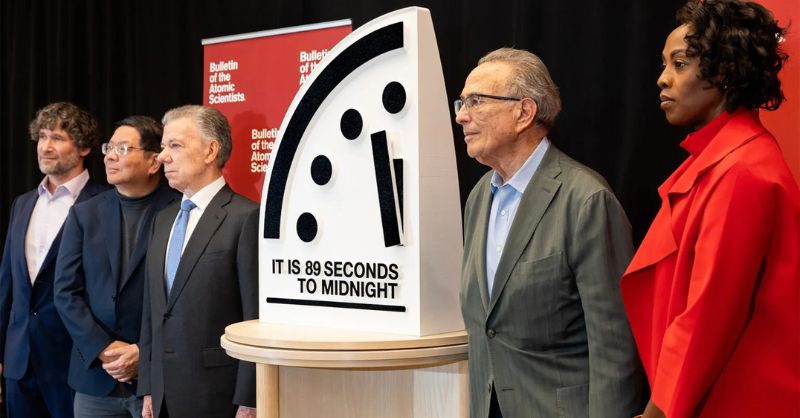
Image credit: thebulletin.org
In January 2025, the Doomsday Clock was set to 89 seconds to midnight, the closest it has ever been. This symbolic timepiece, maintained by the Bulletin of the Atomic Scientists, does not predict the future but serves as a harrowing indicator of humanity’s proximity to existential threats.
From nuclear warfare to climate disasters and the rise of artificial intelligence, the clock’s relentless march toward midnight is a stark reminder of the precarious state of our world.
A while back, we have also written about what they found in NASA’s billion-dollar asteroid sample. It’s an interesting read as well.
Origins of the Doomsday Clock
The Doomsday Clock was conceived in 1947 by the Bulletin of the Atomic Scientists, an organization founded by Manhattan Project scientists concerned about the implications of nuclear weapons. Artist Martyl Langsdorf was commissioned to design the Bulletin’s magazine cover, leading to the creation of the now-iconic clock. The initial setting was seven minutes to midnight, a warning of the nuclear age’s destructive potential.
Over the years, the clock has been adjusted 26 times, reflecting global tensions and crises. In 2007, designer Michael Bierut modernized its appearance. The Bulletin discontinued its print edition in 2009, shifting entirely to a digital platform, ensuring continued global awareness of its updates.
What influences the Doomsday Clock?
Initially, the Doomsday Clock focused solely on the threat of nuclear weapons, but in 2007, the Bulletin expanded its scope to include other existential threats such as:
- Climate change
- Artificial intelligence (AI) risks
- Biological threats and pandemics
- Misinformation and disinformation
- Political instability and global conflicts (e.g., the Ukraine war)
A panel of experts from the Science and Security Board assesses these risks and determines the clock’s time through rigorous analysis and consultation with scientists and policymakers, including Nobel laureates.
How is the clock set?
Originally, Eugene Rabinowitch, the Bulletin’s editor, was responsible for setting the time. Today, the decision is made collectively by the Science and Security Board, which meets twice a year to evaluate global developments. The new time is usually announced in late January.
A timeline of changes
The Doomsday Clock has moved forward and backward over the decades in response to world events:
- Farthest from midnight: 17 minutes (1991) – Following the signing of the Strategic Arms Reduction Treaty and the Soviet Union’s collapse.
- Closest to midnight: 89 seconds (2025) – Reflecting escalating nuclear tensions, climate crises, and AI risks.
- Other notable settings:
- 1953 (2 minutes) – After the U.S. and Soviet Union tested thermonuclear weapons.
- 2020 (100 seconds) – Due to geopolitical instability and climate change.
- 2023 (90 seconds) – Following Russia’s invasion of Ukraine and other global uncertainties.
Key historical events influencing the clock include:
- 1949: Soviet Union’s first atomic bomb test
- 1962: Cuban Missile Crisis
- 1972: Strategic Arms Limitation Treaty (SALT I)
- 1988: Intermediate-Range Nuclear Forces Treaty
- 2006: North Korea’s nuclear test
- 2023 & 2025: Russian invasion of Ukraine
The purpose and public impact
The Doomsday Clock aims to raise awareness and spur action to mitigate global threats. It serves as a metaphor for the dangers of human-made crises. However, the growing anxiety surrounding its announcement has been linked to increased public stress, particularly among individuals with paranoid ideation.
Criticism and controversy about Doomsday Clock
Despite its significance, the clock has faced criticism:
- Some view it as a political stunt, reflecting ideological biases rather than objective security assessments.
- Critics argue that combining multiple threats (nuclear war, climate change, AI) dilutes its message.
- Others believe it lacks a transparent methodology for determining the time.
- Skeptics question whether climate change should be equated with nuclear war in terms of immediacy.
- The focus on broad threats may lead to inaction rather than urgency.
Cultural influence of Doomsday Clock
The Doomsday Clock has become an enduring cultural icon, referenced in:
- Music: Songs by The Who, The Clash, Midnight Oil, Iron Maiden, and Sting.
- Literature: Novels by Stephen King.
- Comics: Watchmen prominently features the clock.
- Film & Music: Linkin Park’s album Minutes to Midnight references the concept.
Final thoughts: Can we turn back the clock?
The Doomsday Clock is a warning, not a prophecy. The 2025 setting of 89 seconds to midnight underscores the urgent need for international cooperation, scientific responsibility, and diplomatic leadership. Addressing nuclear risks, climate change, and technological threats is critical to ensuring humanity’s survival.
The question remains: Will we act in time to push back the hands of the clock?



